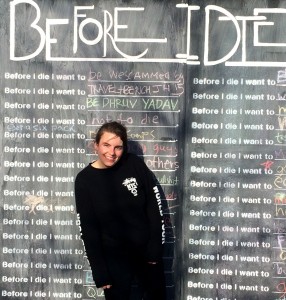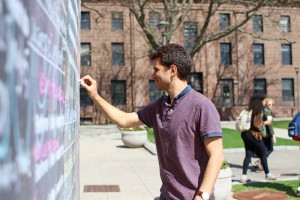McIntyre ’17 Brings “Before I Die” Public Art Project to Wes


In this issue of News @ Wes, we speak to Laura McIntyre from the Class of 2017.
Q: Laura, please tell us where you’re from and what you’re majoring in.
A: I’m a sophomore here at Wes. I’m majoring in sociology and am thinking about the film minor. I’m from New York City.
Q: I understand the “Before I Die” public art project has been installed in locations all over the world. When and how did this project come to be?
A: The project was started by an artist named Candy Chang as a personal project after someone close to her died. She used the side of an abandoned building in her neighborhood in New Orleans, and covered it with the statement that’s now been used on all the walls following: “Before I die I want to _______.” To her surprise, people really jumped on the idea and started writing on it. That original wall was made in 2011 and, since then, there have been over 550 renditions.
Q: How did you first learn about the project? Why did you decide to bring it to Wesleyan?

A: This summer, while compiling videos for an internship project, I found a TED Talk by Candy Chang about her process of putting the project together. I transferred into Wesleyan at the beginning of this school year from Wheaton College in Massachusetts. In thinking about the “Before I Die” wall, and the energy this school provided in a way that Wheaton never did, I started considering the prospect of bringing it here. I felt that perhaps the community here would be more receptive to the idea and the final product than people at Wheaton would have been. That was the starting point.
Q: Did you collaborate with any other students or faculty in bringing it to Wesleyan?
A: Yes, I did! I had this idea, and was pretty passionate about it, but I didn’t know how to bring it to fruition. First semester was like a little cookie crumb trail of people, each person leading me to the next relevant one. I spoke with staff in the CFA, students on the WSA, several student club members, and two artists that work outside Wesleyan who were interested in making the structure. Second semester, I received funding from the student club DIY, and it was at that point that I realized the structure would be made by students, not external artists. Friends were involved in different parts of the process, from building the panels in the wood shop, to painting and stenciling, to advertising, to assembling the panels into the cube outside Usdan. So, yes, in that way I feel like a lot of people, both students and faculty, were involved in bringing this project to Wes, and for that I am extremely grateful.
Q: What has the response/participation been like?
A: The first day it was up, it poured all day, and that bred some fear about how the cube would endure the elements and, hence, how people would respond after seeing it so forlorn and empty. But by Tuesday, those passing by were writing on it, reading the statements that had already been chalked in, taking pictures. The four walls have been filled in for the most part since then. Part of the process is recording the state of the wall, and then cleaning it to provide a blank slate again. We did that on Wednesday afternoon and again this past Monday. Participation can so clearly be measured with this project because the writing on the walls act as a visual ruler. Luckily, participation has been great!
Q: Can you tell us about the range of responses you’ve seen?
A: There really has been such a variety. The responses range from lighthearted and comedic to sentimental and serious. There have been drawings, answers that are spin offs of those already written nearby, quotes. A lot of the answers aren’t narrowly things one wants to “do before they die,” in a bucket list type of way. They are rather thoughts, ambitions, ideas someone wants addressed, with varying degrees of immediacy. I think that’s great, because this platform has perhaps provided a space to think about those wants, and make them visible for the self, and for the people one is constantly surrounded by.
One thing that I’m curious about is how the answers vary in frankness, depending on when they’re written, or whether the person writing is alone or with friends. That isn’t something I can answer, rather just something I’ve thought about based on the variety. When there are two lines next to each other and one reads, “Before I die I want to eat a raisin,” while the next one reads, “Before I die I want to know what it feels like to be loved,” I question what enabled such a difference.

Q: What reactions have you heard from community members about the project and what it was like for them to view it or participate?
A: I’ve heard positive reactions from those who know I’m involved in the project. I think a lot of people don’t know who’s behind it, and I’m quite content with that. I’m content with the project being about the finished product, rather than the people who produced it. One outcome of that, though, is that I haven’t heard as much commentary about what people on campus think. The random tidbits I have heard have been a combination of congratulatory remarks and enthusiasm. The best come from students that don’t know I’m involved, because they seem the most genuine. I was talking with someone recently and she said she had to go because she wanted to write on the “Before I Die” cube. She asked if I’d done so yet and I said I had. She said, “Yeah, it’s awesome, I like looking at what people write.” She had no idea I was involved. That was a pretty cool moment.
Q: How did you answer the question yourself?
A: You know, I’ve realized that if I don’t think too hard about the question, I can answer it pretty easily with humor. If I give the question a moment of my time, the answers are harder to come by, and when they do come they’re more abstract. They fall more into the sentimental category, the type of answer you’d find photographed because they’d be on a lot of people’s bucket lists. Most recently I wrote “Before I die I want to thank…” and then the initials of all the people who participated in putting the project together. I wanted to make sure I did that before I die, for sure, but also wanted to make sure I wrote that on the cube itself.
Q: What will happen to the cube after it’s taken down from its spot outside Usdan? Will it have a permanent exhibition place?
A: It won’t have a permanent home. Much of this project is about its impermanency–the idea that thoughts are written and eventually written over or erased, that natural elements can unexpectedly undo what’s been done with chalk. To keep it permanently somewhere would remove that aspect of the process. Plus, on a very practical level, the materials aren’t the most durable for long-term use. The panels are actually going to be repurposed for two students’ Sculpture 1 final project.

